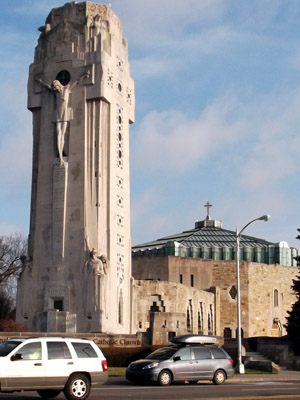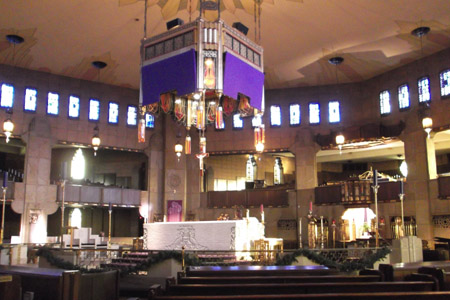| |
 |
 |
 |
| Comment on this report, or find other reports. |
 |
| Our Mystery Worshippers are volunteers who warm church pews for us around the world. If you'd like to become a Mystery Worshipper, start here. |
 |
| Find out how to reproduce this report in your church magazine or website. |
|
|
| 2469: National
Shrine of the Little Flower, Royal Oak, Michigan, USA |
 |
 |
 |
Mystery
Worshipper: Paterfamilias.
The church:
National
Shrine of the Little Flower, Royal Oak, Michigan, USA.
Denomination:
Roman Catholic,
Archdiocese of
Detroit.
The building:
One of the most unusual structures I have encountered. It is
octagonal, with the altar in the very center of the church,
and seating surrounding it on all sides. This is not due to
a renovation after Vatican II; rather, this is the way it was
built in the early 1930s. The altar is of solid Italian marble
and weighs 18 tons. Over the altar is a baldacchino, the top
of which is made of oak, with stained glass underneath the oak
representing the flames of the Holy Spirit. In front of the
church is the Charity Crucifixion Tower, with a 28 foot high
figure of Christ on the cross. The Ku Klux Klan had burned crosses
on the church property in the parish's early days, and this
was intended as a cross they could not burn. This just begins
to describe the richness of the building and grounds, described
on the parish's website. It was declared a national shrine by
the United States Conference of Bishops in 1998.
The church:
The parish began when the then-Archbishop of Detroit, Michael
Gallagher, went to Rome for the canonization of St Therese de
Lisieux (widely known as the Little Flower, hence the church's
name) in 1925, only 28 years after her death at the age of 24.
He was determined to build the first parish in the United States
in St Therese's honor. He chose the charismatic (and later quite
controversial) Father Charles Coughlin as the church's first
pastor. To help fund the building, Father Coughlin undertook
a radio ministry that eventually was attracting an estimated
30 million listeners weekly. However, his vigorously expressed
fascist and antisemitic political views led to the cancellation
(in 1942) of his radio broadcasts and newsletter under threat
of being defrocked and charged with sedition. Coughlin remained
pastor of the Shrine until 1966. Today the parish boasts a membership
of over 4,300 families, with eight weekend masses (one in Spanish)
and two masses each weekday. They support several schools, collectively
providing education from age 3 through high school. There are
the usual social justice, bereavement, and social activities,
and a strong emphasis on Christian formation.
The neighborhood:
Royal Oak is one of Detroit's northern suburbs. In front of
the church is the busy Woodward Avenue, with fast food restaurants,
gas stations, etc. Behind the church can be found middle-class,
single family housing.
The cast:
I am guessing (from photos on the Shrine's website) that the
prayer service was led by the pastor, the Revd Msgr William
Easton, and that the pianist was Greg Grobis. However, there
was no printed bulletin or service leaflet, so no clergy or
musicians were identified.
The date & time:
December 17, 2012, 7.00pm.
What was the name of the
service?
Taizé and Communal Penance Service.
How full was the building?
The building seats 3000, but that includes an extensive balcony.
I will guess 400-450 were in attendance, but given the unusual
design of the church, I'm not sure how accurate my guess is.
Did anyone welcome you personally?
No. There were no ushers.
Was your pew comfortable?
Quite.
How would you describe the pre-service
atmosphere?
Very quiet, as appropriate for a penance service.
What were the exact opening words of the
service?
"In the name of the Father, and of the Son, and of the
Holy Spirit."
What books did the congregation use during the
service?
Gather Comprehensive, a hardbound hymnal published
in 1994 that is found in many Catholic churches.
What musical instruments
were played?
Piano and violin. There was also a quartet of singers. Music
texts were projected onto two large screens, in front of the
balcony on either side of the altar.
Did anything distract
you?
I had expected a typical Taizé service, but I realized
after it began that the Taizé chanting would come later,
as the service was to be primarily an opportunity for everyone
to make their private confession to one of the 16 or 17 priests
who were present. I actually thought about leaving (this Lutheran
would not be so brazen as to ask a Catholic priest for absolution).
But I stayed, and ultimately was glad that I did.

Was the worship stiff-upper-lip,
happy clappy, or what?
It was a formal liturgy, but only as a prelude to private confession.
It lasted about 25 minutes and opened with a prayer, followed
by scriptural readings, a brief homily, an examination of conscience,
and a litany. The Taizé part of the service began as
congregants lined up for their confessions. The six musicians
began singing and playing the simple refrains and ostinati from
the Taizé tradition, and a few of us in the congregation
joined with them quietly. The singing continued in this vein
for a bit more than an hour.
Exactly how long was the
sermon?
As I had never experienced preaching in a Taizé service
before, I did not bring my watch, but I would estimate 6 to
7 minutes.
On a scale of 1-10, how
good was the preacher?
8 – The pastor was very low key but an effective speaker.
He moved around a bit, as he was surrounded by congregation
on all sides.
In a nutshell, what was
the sermon about?
He began by noting the school massacre in Connecticut that had
happened only three days earlier. He said that while the murders
might show us to be a sinful and more godless society, we cannot
point fingers at others – we are here this evening to confess
our own sins. We must ask God to strengthen us, so that this
Christmas his coming will be more concrete, more real.
Which part of the service
was like being in heaven?
Singers, pianist, and violinist were superb; they obviously
have experience with Taizé. Everything was very reverent,
very peaceful. The pianist's improvisations between different
refrains were restrained, yet beautiful in their simplicity.
And which part was like
being in... er... the other place?
As I noted above, I was expecting something a bit different; I felt more than a little out of place at an evening where private confession was the primary event. But ultimately I'm glad I remained.
What happened when you hung around after the service looking lost?
Once individuals had made their confession, they either left
or came back to their pew and joined in the singing. But by
the time I left, there were very few congregants remaining,
and all left quietly.
How would you describe the after-service
coffee?
There was none.
How would you feel about
making this church your regular (where 10 = ecstatic, 0 = terminal)?
5 – I think I'll remain Lutheran. But I would love to go
back to a Taizé service there that is not in a penitential
season, especially if these wonderful musicians were going to
be present.
Did the service make you
feel glad to be a Christian?
Yes.
What one thing will you remember about all this in seven days' time?
As I drove home, I could not help but think about the Connecticut
parents who had buried their children earlier in the day. As
the father of two, I could not imagine what it would be like
for a parent to go through such a service. I found the songs
we sang so appropriate ("Our darkness is never darkness; in
your sight the deepest night is clear as the daylight") at this
time of our national trauma. I'm glad I didn't leave. |
|
|
 |
 |
 |
| We rely on voluntary donations to stay online. If you're a regular visitor to Ship of Fools, please consider supporting us. |
 |
 |
 |
| The Mystery Pilgrim |
 |
| One of our most seasoned reporters makes the Camino pilgrimage to Santiago de Compostela in Spain. Read here. |
 |
 |
 |
| London churches |
 |
| Read reports from 70 London churches, visited by a small army of Mystery Worshippers on one single Sunday. Read here. |
| |
|
|
|
|


